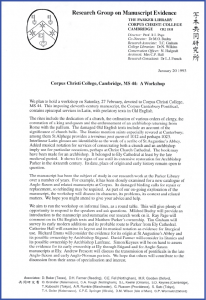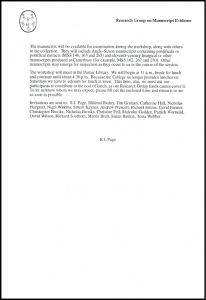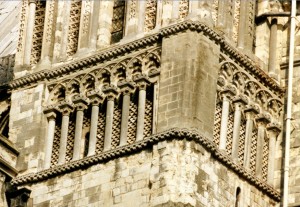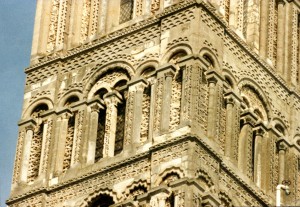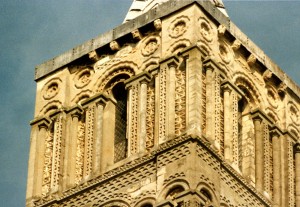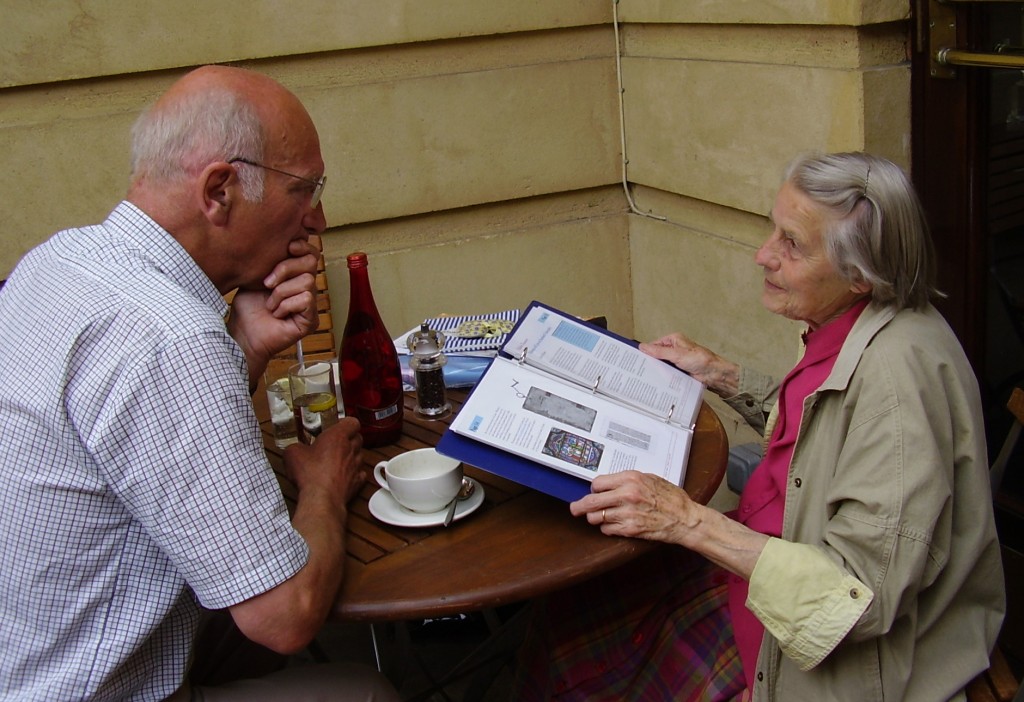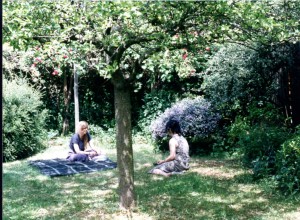Seminar on the Evidence of Manuscripts (February 1993)
September 30, 2016 in Manuscript Studies, Seminars on Manuscript Evidence, Uncategorized
“Corpus Christi College, Cambridge, MS 44:
The Corpus Canterbury Pontifical”
Parker Library, 27 February 1993
In the Series of Seminars and Workshops on “The Evidence of Manuscripts”
The Parker Library, Corpus Christi College, Cambridge
2-page Invitation in pdf, with 1-page RSVP Form.
This Workshop followed the Workshops and other Events
of the Research Group on Manuscript Evidence
in Japan in November and December 1992.
The previous Seminar held in England took place in Oxford and considered
“Research on Anglo-Saxon Manuscripts in Cambridge and Oxford”
Pembroke College, Oxford, 20 June 1992
*****
The Plan
Dated 20 January 1993, the 2-page Invitation Letter (shown here and downloadable here with the 1-page RSVP Form) provides the Menu for the Food for Thought.
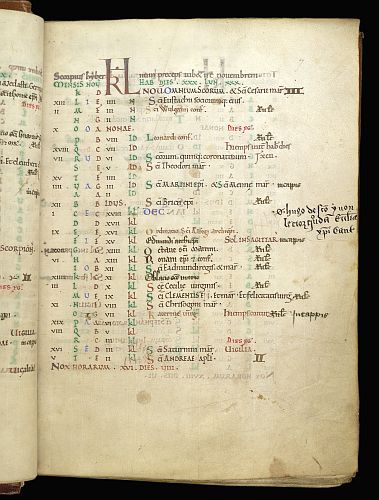
© The British Library Board. Arundel MS 155, folio 7r. November in the Kalendar of the Arundel Psalter, recording the ordination of Saint Alphege.
We plan to hold a workshop on Saturday, 27 February, devoted to Corpus Christi College, MS 44. This imposing eleventh-century manuscript, the Corpus Canterbury Pontifical, contains episcopal services in Latin, with prefatory texts in Old English.
The rites include the dedication of a church, the ordination of various orders of clergy, the coronation of a king and queen and the enthronement of an archbishop returning from Rome with the pallium. The damaged Old English texts include an account of the significance of church bells. The litanies mention saints especially revered at Canterbury; among them St Alphege provides a terminus post quem of 1012 and perhaps 1023. Interlinear Latin glosses are identifiable as the work of a scribe of St Augustine’s Abbey. Added musical notation for services of consecrating both a church and an archbishop imply use for particular occasions, perhaps at Christ Church Cathedral. The book may have been made for an archbishop. It belonged to Ely Cathedral at least by the late medieval period. It shows few signs of use until its extensive restoration for Archbishop Parker in the sixteenth century. Its date, place of origin and early history remain open to question.
The Years’ Long Focus of Research
As the Letter explains,
The manuscript has been the subject of study in our research work at the Parker Library over a number of years. For example, it has been closely examined for a new catalogue of Anglo-Saxon and related manuscripts at Corpus. Its damaged binding calls for repair or replacement, so rebinding may be required. As part of our on-going exploration of the manuscript, the workshop will discuss its character, its problems, its context and related matters. We hope you might attend to give your advice and help.
At Least “Two Sides to Every Storey”
The claims for the manuscript are multiple, especially when viewed across the centuries.
1. Saint Augustine’s Abbey as Possible Maker
With a view toward the Cathedral. For the Corpus Canterbury Pontifical: its Archbishop as a possible patron included. Currying favour may have seemed a Good Plan.
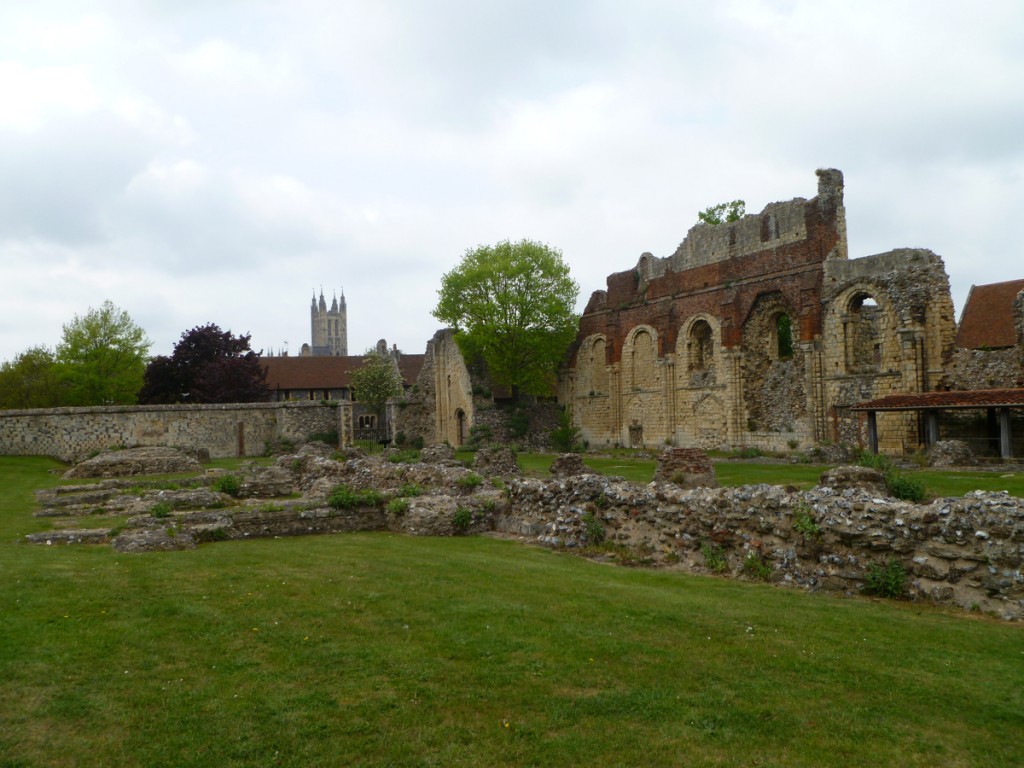
Ruins of Saint Augustine’s Abbey, with a view toward Canterbury Cathedral. Photograph by Casey and Sonja, via Wikipedia Commons.
2. Canterbury Cathedral or Its Archbishop(s) as Early Owner
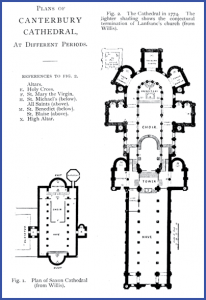
Plans of Canterbury Cathedral at Different Periods: ‘Saxon Cathedral’ and ‘In 1774’. Hartley Withers, ‘The Cathedral Church of Canterbury’ (1897), page 130.
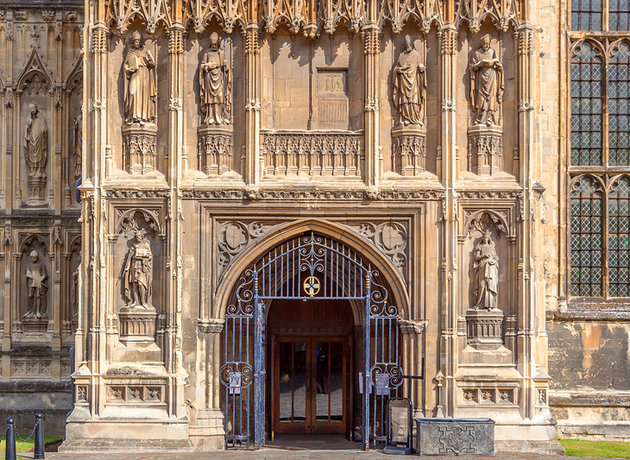
Southwest Porch of Canterbury Cathedral, with niches filled by 1869 with sculptures by Theodore Pfyffers. Photography
Which Archbishop? How about, say, Lanfranc (as seen in an early image, in Bodl MS 569)? And as presented full-length sternly among the architectural sculptures of 1864–1869 by Theodore Pfyffers placed in niches over the SouthWest Porch of Lanfranc’s successors’ Cathedral?
What with the Norman Conquest as an Interruption, To Put It Mildly?
More Than Two Sides To Every Storey. ‘Nuff Said?
*****
3. Ely Cathedral
Collecting the Spoils?
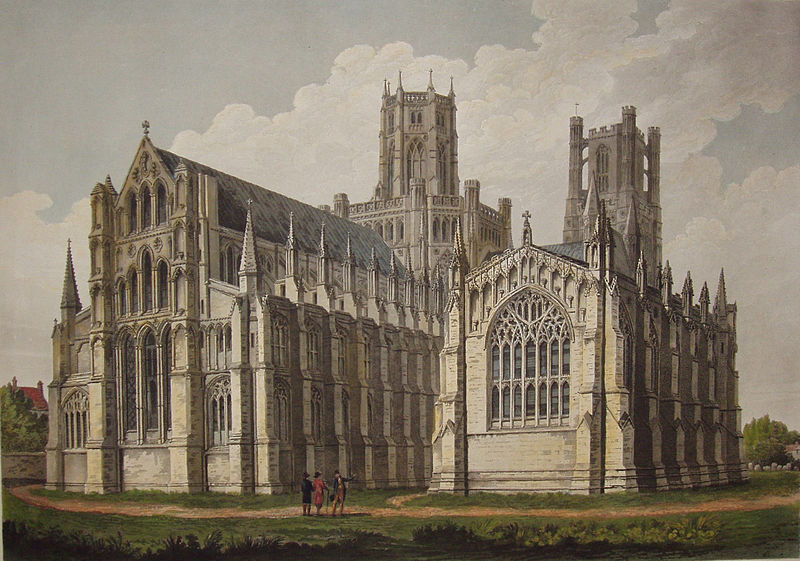
Ely Cathedral, North-East aspect. Proof of Print by John Buckler (1770-1851), via Wikimedia Commons.
Collecting the Spoils, Part II
From Ely after the Reformation into the hands of Matthew Parker. Our detailed research on the manuscript and the evidence for its history makes it possible to identify possible routes from Ely to Parker, and to name names. Not forgetting some associations and affiliations arising from, through or around the marriage in January 1567 of his son John to Joana, daughter of Richard Cox, Bishop of Ely. There are other candidates, too. The entry for MS 44 (Number 46) in the Illustrated Catalogue of Anglo-Saxon, and Early Anglo-Norman Manuscript Art at Corpus Christi College, Cambridge (1997) tells the tale. The current state of the entry distributed among the Handouts at the Workshop spells it all out.
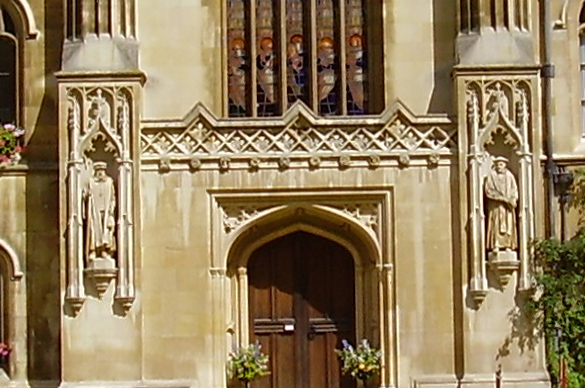
Matthew Parker stands outside the entrance to the Chapel in his College. August 2005. Photography © Mildred Budny.
The Speakers
We return to the Invitation Letter. As it says, as usual,
We aim to run the workshop on informal lines, as a round table. This will give plenty of opportunity to respond to the speakers and ask questions.
The subjects:
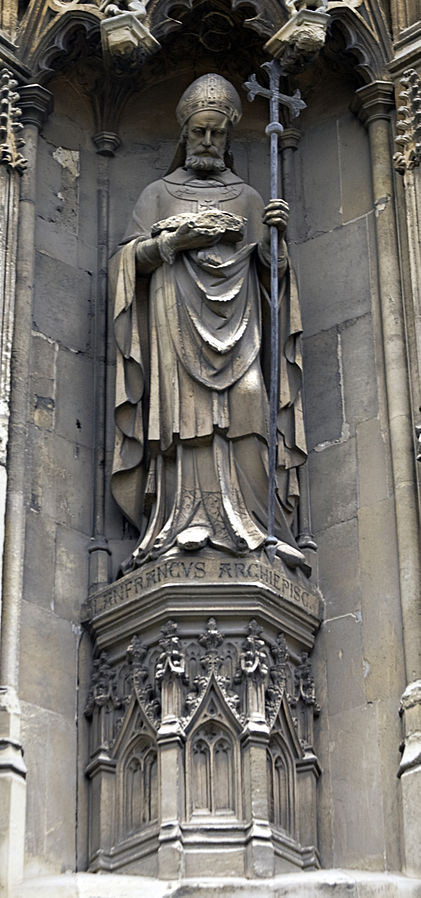
Statue of Lanfranc, Archbishop of Canterbury, in sombre mood. Southwest Porch of Canterbury Cathedral. Photograph by Ealdgyth via Creative Commons.
Mildred Budny will provide an introduction to the manuscript and summarise our research work on it.
Ray Page will comment on its Old English texts and Matthew Parker’s ownership.
Tim Graham will survey its early modern additions and its probable route to Parker from Ely Cathedral.
Catherine Hall will examine its layout and its musical notation as evidence for liturgical use.
Richard Emms will consider the evidence for its origin at St Augustine’s Abbey and its possible ownership by Archbishop Stigand.
David Farmer [David Farmer] will consider its litanies and its possible ownership by Archbishop Lanfranc.
Simon Keynes will be on hand to assess the evidence for its early ownership at Ely through Stigand and for Anglo-Saxon manuscripts at Ely.
Andrew Prescott will discuss the transmission of pontificals in the late Anglo-Saxon and early Anglo-Norman periods.
As always, “We hope that others will contribute to the discussion from their areas of specialisation and interest”.
The Manuscript(s)
The manuscript will be available for examination during the workshop, along with others in the collection. They will include Anglo-Saxon manuscripts containing pontificals or pontifical extracts (MSS 146, 163 and 265) and eleventh-century liturgical or other manuscripts produced at Canterbury (for example, MSS 162, 267 and 270).
As usual, “Other manuscripts may emerge for inspection as they occur to us in the course of the session”.
The Logistics
As usual,
The workshop will meet in the Parker Library. We will begin at 11 a.m., break for lunch and continue until about 4:30 p.m. Because the College no longer provides lunches on Saturdays we have to adjourn for lunch in town. This time, alas, we must ask our participants to contribute to the cost of lunch, as our Research Group funds cannot cover it. To let us know whom we may expect, please fill out the enclosed form and return it to me as soon as possible.
The Participants
![© The British Library Board, Royal MS 10 A.XII, folio 2v. Miniature of Dunstan as a bishop, writing a commentary of the Rule of Saint Benedict, with an inscription 'S[an]c[tu]s Dunstanus'. Reproduced by permission](https://manuscriptevidence.org/wpme/wp-content/uploads/2016/08/K90098-50-222x300.jpg)
© The British Library Board, Royal MS 10 A.XII, folio 2v. Saint Dunstan writes in formal mode while wearing the pallium as archbishop.
R.I. Page, Mildred Budny, Tim Graham, Catherine Hall, Nicholas Hadgraft, Nigel Wilkins, Simon Keynes, Andrew Prescott, Richard Emms, David Farmer, Christopher Brooke, Nicholas Brooks, Christine Fell, Malcolm Godden, Patrick Wormald, David Wilson, Richard Southern, Martin Brett, Susan Rankin, Tessa Webber, Benedicta Ward.
Present (according to the Notes on the Day in the Research Group Archives):
David H. Farmer, Martin Brett, Richard Emms, Nigel Ramsay, Simon D. Keynes, Jennifer O’Reilly, Andrew Prescott, Pav. Finland, Tessa Webber, Catherine Hall, Nicholas Brooks, Timothy C. Graham, Mildred Budny.
The Archives
The paper folder for this Workshop preserved in the Research Group Archives retains some preparatory notes and the originals or copies of some of the correspondence for the organisation of the event; a full set of the Handouts issued on the day; and the unnumbered 2-page set of Mildred Budny’s handwritten notes in pencil on the day, with the date and place “27.2.93 / PL” (= Parker Library).
That set records on Page 1 the “running order” for the workshop and the “MSS” brought onto the table, then lists on Page 2 the attendees (see above).
The Running Order
The “running order”, which concludes with an unnumbered item (“discussion: whither?”), lists 11 numbered entries with names (or initials) and sometimes with a brief note on the speaker’s subject. There are a couple of changes to the plan sketched in the Invitation Letter, and also to the handwritten plan.
Thus, although not listed on the prior program, Nicholas Hadgraft spoke about the binding, and two of the intended presenters spoke twice: Tim Graham first “briefly” on the Old English, and then on the 16th-century connection (Numbers 4 and 11 in the list); Catherine Hall first on the character of the manuscript, and then on the neumes (Numbers 3 and 8). In the handwritten list, Nicholas Hadgraft’s position was originally Number “6”, before some shifting in some others’ order. A couple of the numbered items shift position, with arrows to indicate the revised sequence, repositioning upward the position for both David Farmer (originally 7) and Simon Keynes (originally either 6, with a “?”, or 9). Those shifts reposition Nicholas Hadgraft’s presentation in the sequence.
An Aside, Completely On Point
Why Bother to Mention?
Ah, Indeed!
The point of reporting the contrasts — not conflicts but variations in this case — between the sequence proposed in the Invitation Letter and the sequence recorded in the handwritten notes on the day is to reflect that the preparations and the accomplishment remained flexible, responding to the developing requirements, potentials, and opportunities, to which the organisation readily responded. (As ever in the history of the Research Group on Manuscript Evidence.) Also to remind us that the aims presented in circulated notices may not completely correspond to the Actuality of the Event.
To state that the actuality differed in certain respects from the advertised plan is partly to State the Obvious. However, in delving into the Research Group Archives at a distance of more than a couple of decades, while I am still alive and sentient, arouses the observation that not so many reports of scholarly events treat their enactments as living entities, with the interaction between the proposed plan and the actualisation. Is that a problem? Depends on the point of view. For the most part, no. People prepare for and come to an event, present their Stuff and/or Listen and provide feedback, and then everyone goes away. Publications in one form or another might ensue, with another sort, or other sorts, of record(s) for the event and its impact.
That the written, circulated, and published records of an event which unfolds in time may differ in certain respects one from another follows just as day follows night, and vice versa. Examples in the tradition of events organised or co-organised by the Research Group on Manuscript evidence include the varying titles announced for the 2003 Colloquium and the changes to a session or two at several of the International Congresses on Medieval Studies over the years. One of our Blogposts describes some changes to an individual’s documentary record from state to state and from State to State: Lillian Vail Dymond.
Not infrequently, as sometimes recorded on our Pages, when individuals or organisations come to publish the materials or research relating to or emanating from our events, our name is dropped, and not in the good way, as in giving respect or consideration, or even an honourable mention, but just plain dumped. One might think, from such records, that we had nothing whatsoever to do with the efforts.
At present, we survey the whole Series of Seminars and other scholarly Events, in this case the Early Series focused upon “The Evidence of Manuscripts”. There is the unusual opportunity whereby the Archives of an international scholarly organisation which became, in the United States, a nonprofit educational corporation, came into the charge of an expert Archivist (Yours Truly), with scholarly interests as well as organizational experience. Plus an abiding love of manuscripts, the written word, and the transmission of knowledge across the centuries. As witness our blog on Manuscript Studies. As stated in our Mission at the front or HomePage of this website.
Hi! You are Here. And Welcome You Are!
The Manuscripts on the Table
Continuing with the Handwritten Authority. Its list of “MSS” cites certain changes. Besides Corpus Christi College, MS 44, of course, the star of the show, these originals also appeared:
MSS 146
162
163
265
81
and the “indenture”.
The last item would refer to one of the indentures founding scholarships from Canterbury to Corpus Christi College in 1569 and bearing Matthew Parker’s seal and signature. The instance chosen by Catherine Hall both for inclusion in the exhibition at the Parker Library on “Matthew Parker In Cambridge” (October 1993 – February 1994) and for photography for its exhibition booklet is Archives XLA 14 (reproduced in part, focusing upon Parker’s signature, in Figure 3 of that booklet). The publication offers a worthy contribution, and we gladly honour its scholarship and dedication.
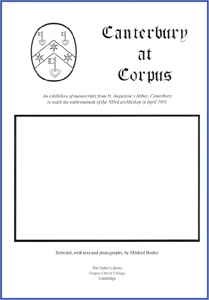
Cover / Poster (minus the pasted-in-photograph from Corpus Christi College MS 286) for the exhibition of ‘Canterbury at Corpus’ held at the Parker Library in 1991.
“Matthew Parker in Cambridge”. Exhibition booklet selected by Catherine Hall, with photography by Mildred Budny (Cambridge: Research Group on Manuscript Evidence, 1993); reprinted in expanded form in Old English Newsletter, 27:1 (Fall 1993), as Appendix A (A-1–8), now available online.
An earlier exhibition booklet includes Corpus MS 44 in its own right. Number 4 here:
“Canterbury at Corpus: An exhibition of manuscripts from St. Augustine’s Abbey, Canterbury, to mark the enthronement of the 103rd archbishop in April 1991“. Exhibition booklet “Selected, with text and photographs, by Mildred Budny (Cambridge: Research Group on Manuscript Evidence, 1991); reprinted in Old English Newsletter, 24:4 (Summer 1991), as Appendix A (A-1–8), not yet online.
Singing from the Manuscript
A treasured highlight of the Workshop on the Corpus Canterbury Pontifical was the sight and sound of Catherine Hall as she stood before its opened pages and sang from its neumed passages. I found it thrilling to witness, and to experience, the use of the manuscript itself for some of the purposes of performance for which it was intended, and for which it had been prepared.
Catherine’s Handouts provided copies of photographs from relevant pages in several manuscripts and her transcriptions of some neumed passages in Corpus MS 44, pages 245, 248, 250, 255 and 264, as well as in Corpus MS 146, pages 63 and 65. Here are specimens from the Antiphons at 1) the anointing of a new Bishop’s hands and 2) the giving of the Pallium (from pages 255 and 264).
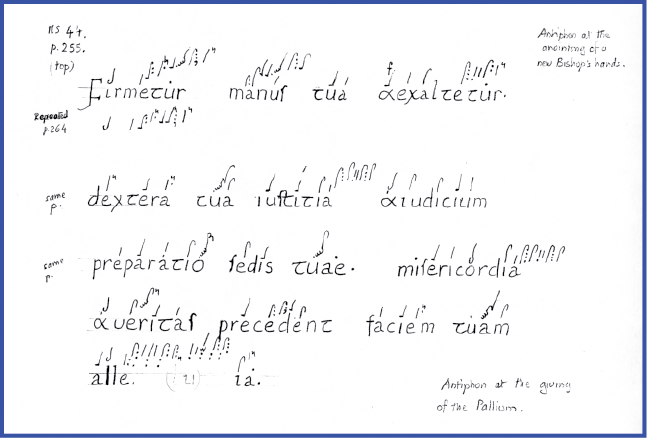
Page 5 of Catherine Hall’s Handout for 27 February 1993. Transcription of Neumed Passages from Corpus MS 44, pages 255 and 264.
Already, from many conversations (including those related to the preparations for the “Canterbury at Corpus” exhibition, I knew that Corpus MS 44 was one of Catherine’s favorite manuscripts, and that she belonged to a local choir, with which she regularly performed. (They knew here there by her “other” name, her middle name, Priscilla.) It seemed natural, as well as fortunate, that she contributed her combined expertise to the event.
This moment, bringing the manuscript back to life, in both words and song, forms one of the best memories from the whole First Series of Seminars and Workshops of the Research Group on Manuscript Evidence..
Manuscript Responses
The Research Group Archives preserve the handwritten responses to the Invitation Letter which express regrets from esteemed colleagues. I transcribe them here, using a forward slash (/) to indicate the turning from the recto to the verso of the card or letter.
Vivien Law‘s double-sided postcard on Sidney Sussex College letterhead, dated “Thursday” and addressed to “Dear Milly”, offers
Many thanks for your/Ray’s invitation to the workshop on Corpus 44. At the moment I’m so pressed for time that I’ve even sunk to the level of cancelling supervisions, / something I don’t think I’ve ever done before except when flat on my back with a good uncompromising bug!
In the circumstances, no, regretfully,
Yours,
Vivien
Richard Southern‘s double-sided letter, headed with the imprint of both the announcement that it comes “From: Sir Richard Southern” and his Oxford home address, bears both his date “24.1.93” and salutation “My dear Page”. Then it sets out his reasons, plus a suggestion.
I think the idea of a ‘workshop’ as especially one on CCCC 44 is a splendid one & I should love to come. But I’ve become so deaf that I cannot (with all the apparatus in the world) hear anything anyone says. So I fear I must renounce the pleasures of being present & I’ll look forward to reading the results if, as I hope, you are intending to publish them.
May I suggest the name of someone who (I’m pretty sure) would / like to come & can contribute to the subject:
Sister Benedicta Ward SLG
Convent of the Incarnation
Fairacres
Oxford
with best wishes,
Yrs
Richard Southern
The Archives include a copy of Mildred Budny’s handwritten letter of 3 February 1993 inviting Sister Ward to the workshop. There is no sign of a response, nor did Sister Ward attend, although we hoped for her presence.
*****
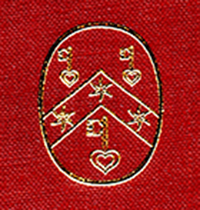
The Feedback
The Handouts include up-to-date printouts of the catalogue entries for Corpus MSS 44, 146, 163, and 265, Part I. The Workshop presented the occasion for feedback and refinements to their descriptions.
There is also a handwritten page which represents a dialogue as the proceedings advanced, only partly according to plan. Written by a single hand (Yours Truly’s), these lines are broadly spaced, with large letter forms. It is right to infer that there were gestured responses or expressions not put-to-page from the Addressee (although the recorded half of the Dialogue was in fact Put-To-Page in both senses).
Ray,
What do you think about timing? Now 5. [i.e. p.m.]
Very cold [underlined], what
Aim for what time end?
Andrew still to talk
There follows the more calmly composed notes summarising Andrew Prescott’s presentation, with references, for example, to Cotton MS Vitellius A VII and Additional MS 28118 in the British Library.
*****
The Handbook and the Illustrated Catalogue
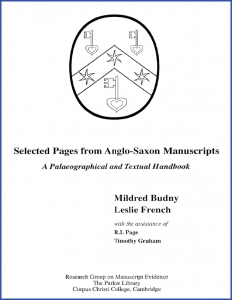
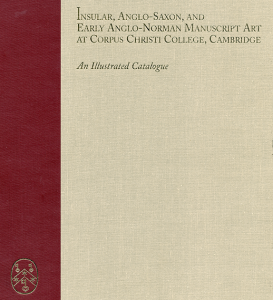 Corpus Christi College, Cambridge, MS 44 also figures in
Corpus Christi College, Cambridge, MS 44 also figures in
- The Palaeographical and Textual Handbook and
- the Illustrated Catalogue of Anglo-Saxon, and Early Anglo-Norman Manuscript Art at Corpus Christi College, Cambridge (1997).
In the Illustrated Catalogue, this manuscript is Budny, Number 46. In the Palaeographical and Textual Handbook, it is Number IX.
A preview of the Handbook formed the subject of one of the earliest Seminars in the Series on “The Evidence of Manuscripts”:
“Facsimiles, Diplomatic Texts and Editions”
(Preview of
The Palaeographical and Textual Handbook)
Parker Library, 17 March 1990
A description of its approach appears in the Report prompted by a later Seminar:
Anglo-Saxon Manuscripts from Worcester”
Pembroke College, Oxford, 13 March 1993
Published here:
Mildred Budny, “Worcester Manuscripts at Corpus Christi College, Cambridge: A Report on Recent Research, Old English Newsletter, 26:3 (Spring 1993), 22-35, now online.
A new Report, with a specimen Depiction, appears in the 2016
Interview with our Font & Layout Designer, also the co-author of the Palaeographical and Textual Handbook.
*****
The next Seminar again took place in Oxford. It considered
“Anglo-Saxon Manuscripts from Worcester”
Pembroke College, Oxford, March 1993
See the full list of Seminars and Workshops on “The Evidence of Manuscripts”. A fine run.
*****

